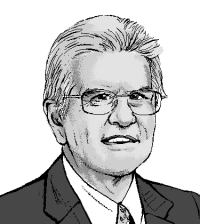Byzantine and Catholic
Millions of Christians worship like the Orthodox but are aligned with Rome. Andy Warhol was one of them.

The Brooklyn Museum currently has a stunning exhibition titled Andy Warhol: Revelation (through June 19). The show is indeed a revelation in its emphasis on the spiritual dimensions of Warhol’s work, and it properly stresses its intimate relationship with the religious tradition in which he grew up, with its ancient traditions of icon painting. Warhol’s antecedents—the family name was originally Warhola—lay in what we would now call eastern Slovakia, where the prevailing tradition was Byzantine Catholic.
That combination of names might puzzle many American Protestants—how can you be both Byzantine and Catholic?—but it speaks to a potent spiritual phenomenon found across very different parts of the Christian world.
Historically, Catholic and Orthodox churches diverged substantially, over patterns of liturgy and devotion, disciplinary matters such as priestly celibacy, and simple customs. (How exactly should you cross yourself? And how many times?) The key division, however, was acknowledgment of the supremacy of the Roman pope. Over time, different Christian populations encountered each other in a variety of ways—sometimes through evangelism, sometimes through conquest—and a new synthesis emerged. Some groups from Orthodox or Oriental Orthodox traditions accepted papal headship and entered full communion with the Roman Catholic Church, but they retained most of their older customs. Although Catholic by obedience, their churches continue to look and sound Orthodox.
Read our latest issue or browse back issues.
There are presently 23 such Eastern rite or Uniate churches with a combined total of 20 million members. More than 80 percent of these members are found in just five bodies: the Ukrainian Greek Catholic Church, the Syro-Malabar Catholic Church (southern India), the Maronite Church (Lebanon), the Melkite Greek Catholic Church (Syria), and the Armenian Catholic Church.
The Ukrainian Greek Catholic Church is the largest of all, with 5 million members. The church traces its origin to the 16th century, when the militantly Catholic Polish-Lithuanian Commonwealth detached many of the churches of Ukraine and Belarus from the Orthodox Patriarchate. The critical date was 1596, with the Union of Brest-Litovsk. In modern times, that church suffered grievously from political repression and overt religious persecution, which produced many celebrated martyrs. Ukraine’s Catholics found themselves under Soviet Communist rule—at a time when the Communists found any foreign or Western ties deeply suspicious. In 1946, the Soviets liquidated the church as an organizational unit and forced its members to rejoin the Orthodox Church, which was of course under rigid state control.
Ukraine’s Greek Catholics maintained a clandestine existence until the Gorbachev years, when their church was recognized once more. Today, Eastern rite Catholics account for around 10 percent of Ukraine’s population, heavily concentrated in its western regions. Their historical memories make them among the strongest opponents of Russian aggression and potential occupation.
Far smaller than the Ukrainian church is another Eastern rite community that emerged in Ruthenia, south of the Carpathian Mountains, among the Carpatho-Rusyn people. In the 17th century, a large group of Orthodox clergy in this region tried to escape the inferior status they held under Catholic domination. Following the model of the Brest-Litovsk agreement, they accepted papal supremacy while retaining their Byzantine liturgy. They thus created the Ruthenian Greek Catholic Church, which in the United States is called Byzantine Catholic. Like their Ukrainian Catholic neighbors, this church too suffered horribly under Communist rule. One young and charismatic bishop, Theodore Romzha, was murdered by the Soviet secret police in 1947 and subsequently beatified as a martyr by Pope John Paul II.
Today, the church has a meager 400,000 members worldwide, but its American presence has given it disproportionate visibility. From the 1880s, the Ruthenian region was the source for many migrants to America’s booming industrial heartland, to the mines and steelworks. Still today, some older Pennsylvania towns are marked by a pair of churches, each with its onion dome and Slavic-style crosses: one is Orthodox, the other Byzantine Catholic. The Byzantine Catholic metropolitan province for the United States is headquartered at St. John the Baptist Cathedral just outside Pittsburgh.
Some of those steelworkers concentrated in the area they called “Ruska Dolina,” or Rusyn Valley, now in the Greenfield neighborhood of Pittsburgh. The handsome church that developed there is St. John Chrysostom’s, which would become famous as the family church of the Warholas. As a Rusyn, Warhol himself grew up in a powerfully Byzantine Catholic setting, with its crosses, holy pictures, and statues, which are amply represented in the Brooklyn Museum exhibition. Nor could the family ever forget that mighty tradition of heroes and martyrs.
Later, in New York, Warhol frequently attended St. Vincent Ferrer, a Latin rite church on the Upper East Side, although he felt self-conscious about crossing himself the Ruthenian (and Orthodox) way. Moreover, those icons, with their deep Byzantine past, were strongly imprinted on his mind. You could be faithfully Byzantine and faithfully Catholic, and Warhol was both.







